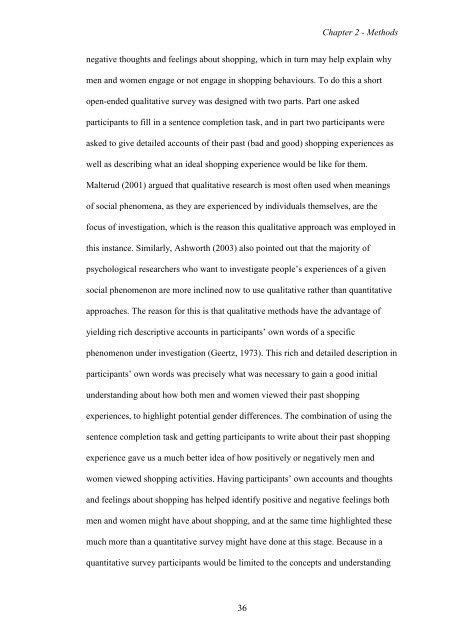CHAPTER 1 - University of Exeter
CHAPTER 1 - University of Exeter
CHAPTER 1 - University of Exeter
Create successful ePaper yourself
Turn your PDF publications into a flip-book with our unique Google optimized e-Paper software.
36<br />
Chapter 2 - Methods<br />
negative thoughts and feelings about shopping, which in turn may help explain why<br />
men and women engage or not engage in shopping behaviours. To do this a short<br />
open-ended qualitative survey was designed with two parts. Part one asked<br />
participants to fill in a sentence completion task, and in part two participants were<br />
asked to give detailed accounts <strong>of</strong> their past (bad and good) shopping experiences as<br />
well as describing what an ideal shopping experience would be like for them.<br />
Malterud (2001) argued that qualitative research is most <strong>of</strong>ten used when meanings<br />
<strong>of</strong> social phenomena, as they are experienced by individuals themselves, are the<br />
focus <strong>of</strong> investigation, which is the reason this qualitative approach was employed in<br />
this instance. Similarly, Ashworth (2003) also pointed out that the majority <strong>of</strong><br />
psychological researchers who want to investigate people’s experiences <strong>of</strong> a given<br />
social phenomenon are more inclined now to use qualitative rather than quantitative<br />
approaches. The reason for this is that qualitative methods have the advantage <strong>of</strong><br />
yielding rich descriptive accounts in participants’ own words <strong>of</strong> a specific<br />
phenomenon under investigation (Geertz, 1973). This rich and detailed description in<br />
participants’ own words was precisely what was necessary to gain a good initial<br />
understanding about how both men and women viewed their past shopping<br />
experiences, to highlight potential gender differences. The combination <strong>of</strong> using the<br />
sentence completion task and getting participants to write about their past shopping<br />
experience gave us a much better idea <strong>of</strong> how positively or negatively men and<br />
women viewed shopping activities. Having participants’ own accounts and thoughts<br />
and feelings about shopping has helped identify positive and negative feelings both<br />
men and women might have about shopping, and at the same time highlighted these<br />
much more than a quantitative survey might have done at this stage. Because in a<br />
quantitative survey participants would be limited to the concepts and understanding
















